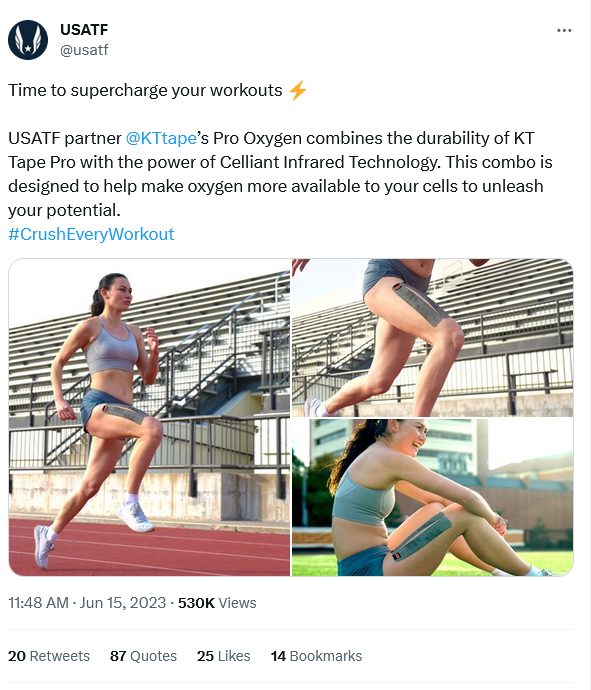
USATF seemingly playing fast and loose with science.
About five years ago I decided to cut back on running (my primary exercise for over 20 years) and focus on developing strength. Initially I struggled, but eventually I fell into a decent groove and was making some actual progress. But several months in, I was feeling a bit beat up. As the squats and presses started getting heavy, my joints started to get a bit…cranky. Somehow I developed both tennis elbow and golfers elbow at the same time. And my knees? They were creaky too. So I invested in knee and elbow sleeves. Sleeves are cloth or more commonly neoprene tubes (think wetsuit material) that you pull over your knee or elbow. Sleeves provide warmth by essentially blocking heat from escaping. They provide a bit of compression as well. Warm joints just feel better that cold joints, and I’ve been wearing them ever since. The benefits are purely subjective, but I’m not trying for any strength records – I’m just trying to get stronger as I age.
While knee and elbow sleeves seem like an effective enough panacea, I’ve never used athletic or “kinesiology” tape, which goes by a number of brand names. It seemingly went from unknown to ubiquitous after the 2012 Olympics, where athletes in multiple sports were spotted wearing the brightly-coloured adhesive fabric strips all over their bodies. Not surprisingly, skeptics were skeptical. The claims seemed implausible, even impossible. Beyond “releasing natural healing power”, coloured tape was said to provide pain relief, reduce inflammation, stabilize muscles and most importantly, improve performance, regardless of the sport. The reality was that it did absolutely none of these things. Paul Ingraham’s Pain Science has a super-comprehensive article about the science behind kinesiology tape, so I won’t reiterate it here. And despite class action settlements with some manufacturers for deceptive advertising, K-tape products remains popular in athletics. The market is now flooded with different brands of brightly coloured tape – I even found some at the local dollar store which represents either the pinnacle (or perhaps the nadir) of success for these brightly coloured placebos.
Understanding Heat Production and Exchange

Conceptual model of using humans to generate heat that doesn’t involve tape. CREDIT: WARNER BROTHERS
To examine the claims of KT tape, it helps to go back to basics. The first law of thermodynamics states that energy cannot be created or destroyed, only altered in form. Energy consumed by our bodies, if it’s not stored, is released either by work or by heat. Our bodies have four mechanisms to regulate our body temperature:
- Conduction is the transfer of heat from two objects that are in direct contact with each other. If you hold something cool against your body, it will warm that object. If you’re cold and hold a warm cup of cocoa, it’s warming you. Not a lot of heat is normally lost from the body due to conduction.
- Convection is the transfer of heat into the air surrounding the skin. Warmer air rises and drifts up, replaced by cooler air. A fan can effectively cool your body through convection, by increasing air exchange and movement around the body.
- Radiation means the transfer of heat energy via infrared. The sun warms your skin with infrared radiation. Your body constantly eliminates infrared energy, accounting for almost 2/3 of energy loss. Thermal imaging cameras and night vision goggles make infrared heat production visible.
- Evaporation is the transfer of heat by water evaporation. Sweating effectively reduces large amounts of heath from the body, and is the primary way for the body to reduce heat when exercising.
So when I put neoprene sleeves on my elbows and knees, I block the heat release from my body in that area because of the neoprene insulation. It’s occlusive and prevents evaporation, but also prevents conduction and radiation. My overall body temperature isn’t affected, but the tissues underneath become warmer. The sleeves do not generate heat – they are reflecting my own heat energy back into joint. When I pull the sleeves off, the skin is warm and flushed. Sleeves don’t just give the perception of warmth – the surface tissue is objectively warmer.
What is Pro-Oxygen tape?
Let’s now look at the sponsorship above between USA Track & Field (USATF) and KT Tape (see top image), which manufactures a product called “Pro Oxygen” and which USATF is now promoting to their followers. It claims that this tape “makes oxygen more available to your cells”. I have a copy of an Outside magazine beside me, which has a KT Tape advertisement on the back cover. The advertisement states, “New Pro Oxygen from KT Tape features embedded Celliant infrared technology that helps delivery more oxygen to your body’s cells.” What exactly is this tape supposed to do – and is it doing it?
KT Tape says their product contains something called Celliant, which they describe as,
Celliant® is a patented blend of natural minerals that transforms body heat into full-spectrum infrared energy to improve cellular oxygenation.† When properly applied, KT Tape Pro Oxygen with Celliant infrared technology makes more oxygen available to cells where it is applied. The ultra-breathable synthetic KT Tape Pro kinesiology tape lifts the skin, while embedded Celliant minerals convert your body’s heat into infrared energy which increases local blood flow and delivers more available oxygen to cells.
I tried to find more about what Celliant is. Their website says,
CELLIANT transforms your body’s heat into full-spectrum infrared energy, promoting local circulation and cell oxygenation while keeping you drier and at the perfect temperature…The full-spectrum infrared energy is reflected back to the body, even through multiple layers of fabric, making it possible for the tissue and muscle to absorb it…The full-spectrum infrared light promotes improved local circulation, making more tissue oxygen available to your cells—an average increase of 7%, and up to 8.4% in a clinical trial*.
* Source: Single Center Prospective Comparative Study to Evaluate the Performance of an Upper Torso Garment, Dr. Ian Gordon, Long Beach VA Memorial Hospital, Journal of Textile Science and Engineering, 2014
I was not able to locate that study, but I was able to find one published trial in the National Library of Medicine that mentions Celliant by name, which was a randomized double-blinded trial of socks in individual with diabetic foot pain, which found that socks that contained Celliant reduced subjective reports of pain compared to “placebo” socks. I do not have access to the complete trial, but am curious if this, if real, could have simply been attributed to differences in how warm the socks themselves were.
Celliant notes,
The FDA determined products containing CELLIANT® are medical devices because they are intended to temporarily increase blood flow and local circulation at the site of application in healthy individuals.
The FDA has determined that CELLIANT® products are medical devices as defined in section 201(h) of the Federal Food, Drug and Cosmetic Act and are general wellness products.
The FDA has not approved or designated CELLIANT® products for any purpose and has not made any determination about, or endorsement of, its stated use or benefits.
To its credit, it does have some research available on its website. However I was unable to find any clinical trials with KT tape embedded with Celliant. There do not appear to be any clinical trials with the product. Celliant claims,
The key differentiator of the PRO Oxygen line compared to KT’s other athletic tapes is the added CELLIANT-derived benefit of improved cellular oxygenation.
What are the Benefits of Improved Cellular Oxygenation?
Infrared energy improves cellular oxygenation by increasing local circulation. Blood flow is the way that our body transports oxygen to the cells, so with improved local circulation comes increased availability of this oxygen. Oxygen is breathed in through the air and then, once in the lungs, it is transferred to the blood. The circulatory system then moves that oxygen to the cells throughout the body. The cells use the oxygen to break down the food energy that they store into a form that is usable by the body to power muscles.CELLIANT is clinically demonstrated to increase tissue oxygen levels by an average of 7% and up to 8.4% in our TcPO2 clinical trials. Improving the oxygen levels has a measurable effect on a person’s strength, endurance and stamina – in short, the more oxygen you can provide your cells, the better.
Reading through the marketing, Celliant simply appears to be a polyester fibre with a “proprietary mix” of ceramic particles embedded within the fibre itself. It is this fibre which is supposed to “reflect” heat back into the body. Presumably more heat reflected means warmer tissue and potentially increased circulation…and that’s how they claim there is more oxygen at the site? But you don’t need special fibres or coloured tape to reflect the heat your body is producing back into the body. Regular clothing, even without Celliant, should be able to do this. You just need to cover you skin.
Skepticism seems justified
I continue to be amazed at the popularity of kinesiology tape. Despite multiple debunkings and even successful class action lawsuits, it continues to be used by amateur and professional athletes alike. Not surprisingly, USATF got a very rough ride on Twitter for their tweet, with multiple exercise scientists pointing out the sheer implausibility of tape on the skin increasing cell oxygenation. As for me, I’ll continue using my knee and elbow sleeves in my workouts, happy with my “old school” way of capturing and reflecting heat.

